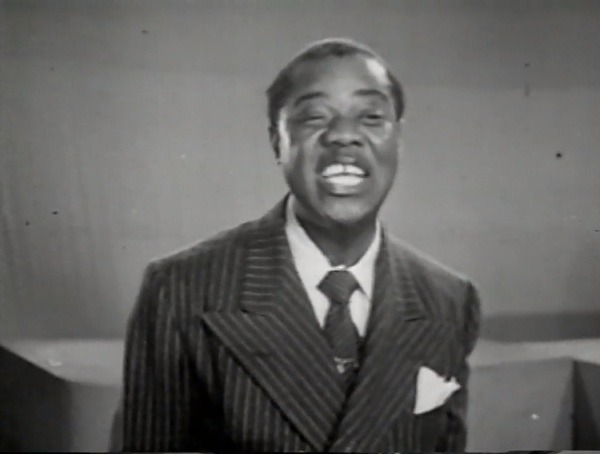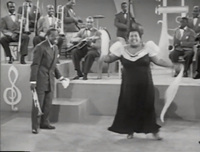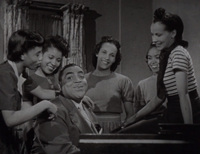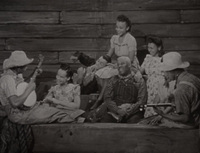Racial Representations on the Panoram

Many famous African American performers of the time would be captured on Soundies, like the legendary Louis Armstrong shown above!
Minorities grappled with a racist U.S. during the period leading up to and including the Soundies. By the 1930s, Jim Crow laws were firmly established throughout much of the South. Jim Crow legislation was a name given to a multitude of mostly state and local laws that legalized segregation of citizens based on the color of one’s skin. Although other areas of the U.S. did not codify Jim Crow laws, informal segregation and discrimination was widespread.58 In addition to separating races, laws and terrorism (i.e., lynchings, harassment, violence, etc.) were often aimed at keeping minorities away from ballot boxes and enforcing an unequal society. African Americans in particular faced these challenges, but other minority races were also impacted. America’s entrance into World War II held racial consequences on the homefront. Japanese Americans abandoned their property and livelihoods and were relocated to internment camps due to racist assumptions about being disloyal to America.59 Latin American laborers and Americans of Latino origin were encouraged to do farm labor while attempts at greater equality largely failed.60 African Americans and other minorities also served honorably in the war but were mostly left out of post-war service benefits like the G.I. Bill and V.A. backed home loans.61 Racial separation and discrimination was also reflected on the silver screen, with minorities often reduced to limited or stereotyped roles and having minimal interracial screentime.62 The racial realities of the times would be reflected, but also challenged, in Soundies.
Dorothy Dandridge seen here with the Mills Brothers performing "Paper Doll."
Interracial and potentially implying sexual undertones for the era, this Roy Eldridge solo would have likely recieved greater scrutiny if shown on a different medium.
When Soundies came into being, their productions included high amounts of minority performers at the time compared to other forms of media. Partially due to a musician strike, low production budgets, and reluctance from movie industry insiders to lend their talent to what they viewed as a competitor in the audiovisual space, Soundies productions sought out up-and-coming talent and minority performers who might otherwise be left out of the industry to record content for the constant need for new Soundies releases.63 Some of the largest minority groups to see involvement were African Americans, Latinx Americans. and Hawaiians.64 Soundies with minorities or minority cultural themes still faced problems and racism as they were frequently branded as “exotic,” mashed up with other cultural aspects to create hyphenated subject crossovers, or had some of the minority roles performed by white entertainers.65 These actions were a way to incorporate dominant white culture into traditional minority genres and has been linked to cultural assimilation into dominant white society.66
African American performers in particular saw greater inclusion on screen, more main roles, and even some interracial scenes normally off-limits to the silver screen.67 Of the around 1,850 Soundies made, about 300 featured African American performers in leading roles.68 Some Soundies even went so far to have entire casts made up of African Americans.69 With the enlarging library of Soundies starring African Americans the Soundies Distribution Corporation decided to place these films under a separate heading when advertising the films for curation by Panoram owners.70 Whether that action was directed to make it easier for Panoram owners wanting Soundies with African American performers or if it was an effort to segregate listings to make the short musical films better received in segregated society remains unknown. Some bigger or up-in-coming African American stars had performances on Soundies, like Nat King Cole, Fats Waller, Duke Ellington, Louis Armstrong, and Dorothy Dandridge.71 These performers brought the musical styles of jazz and the blues, when such musical styles were less frequently recorded.72 Some films could have been construed as quite controversial for the period, as segregated society disapproved of interracial interactions. Soundies like "Thanks for the Boogie Ride" not only featured African American performers and had interracial scenes with the white singer Anita O’Day dancing and singing next to Roy Eldridge, but the film also had suggestive lyrics for the time. At one point Roy Eldridge motions to his horn and says, “here’s your boogie ride,” before commencing a solo after Anita O’Day sings “thanks for the boogie ride,” which has been referred to by some in the scholarly community to stand for intimate relations.73 Not every depiction of African Americans was positive or progressive. Some reverted to racist notions of African tribalism, like "Congo Clambake" which features Dandridge, but this time in stereotypical depictions of native African tribal attire while the song focuses on, as Soundies expert Andrea Kelley states, “... an illustrated lecture on ‘Boogiejive, Africa,’ …” while providing racist depictions of Africans and African culture throughout.74 Others, like the peice "Macnamara's Band," included the shameful use of blackface in a highly racist depiction of a Black French performer. All together, African American involvement in Soundies ranged, from reinforcing stereotypes to being progressive for the era of segregation.
Here Nat King Cole performs on the piano as part of the Nat King Cole Trio. The tight shots are a regular in Soundies.
The increasing role of African Americans and other minorities and the crossing of segregated boundaries came with backlash. One way to limit content was through censorship. A concept that limited much of the film and television industry, censorship boards were active in challenging Soundies material.75 While the Motion Picture Production Code limited cinematic from sexually suggestive content and lyrics, it did not apply to Soundies, but the short musical films did face censorship from state-level censorship bodies.76 These boards appear to have targeted African American led content at higher rates than majority white Soundies, with citations for illicit dancing, lyric inappropriateness, or exposure.77 Many interracial Soundies potentially escaped censorship efforts due to the sheer number of Soundies being released, the oftentimes lengthy review process, and the ability for censored films to be resubmitted and examined again.78 Fears of interracial content found in some Soundies were either entirely banned or had certain content regulated out of release versions by state censorship entities.




